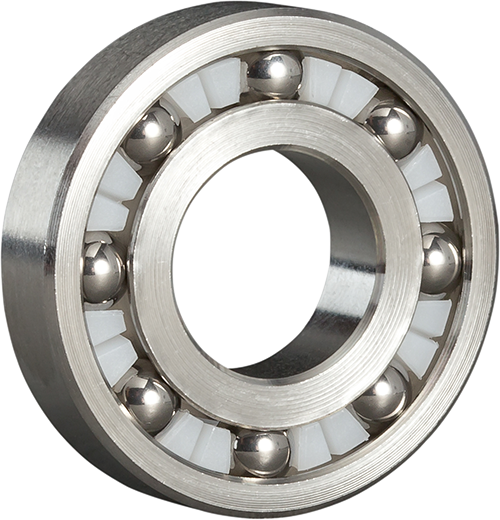316 Stainless Ball Bearings
Standard Tolerances

Tolerances for Mounting and Interference Fits
|
INSIDE DIAMETER |
||
|
MINIMUM |
MAXIMUM |
GENERAL TOLERANCE |
|
0.000" |
1.250" |
+.003", -.0" |
|
OUTSIDE DIAMETER |
||
|
MINIMUM |
MAXIMUM |
GENERAL TOLERANCE |
|
0.000" |
2.500" |
+.0", -.003" |
|
WIDTH |
|
|
MAXIMUM DIAMETER |
GERNERAL TOLERANCE |
|
2.500" |
+/- .005" |
|
DIAMETRIC CLEARANCE |
||
|
BORE (Maximum) |
OUTSIDE DIAMETER |
GENERAL TOLERANCE |
|
0.250" |
1.000" |
free turning to .007" |
|
0.500" |
2.000" |
free turning to .008" |
|
0.750" |
2.500" |
free turning to .010" |
Highlight Features
316 Stainless Corrosion Resistance: Better corrosion resistance than 440c, 302 and 304 stainless. Resists sodium and calcium brines, hypochlorite solutions, phosphoric acid, sulfite liquors and sulfurous acids that are commonly used in the paper pulp industries.
- Molybdenum content increases resistance to marine environments.
- High creep strength at elevated temperatures and good heat resistance.
- Bio-compatible.
- Fabrication characteristics similar to Types 302 and 304.
Applications: Food and pharmaceutical processing equipment, marine environment, surgical medical devices, and industrial equipment that handles the corrosive chemicals used to produce inks, rayons, photographic chemicals, paper, textiles, bleaches, and rubber.
MOUNTING PRACTICE
316 Stainless Ring Characteristics
316 stainless steel is a non-hardenable food and medical grade stainless. KMS 316 stainless raceways are a semi-precision, unground type. Due to the tolerance range of a semi-precision bearing ring, it is recommended that the customer measure the actual bearing to be used for calculating shaft and housing fits.
Interference Fits
A typical application would be a press fit to one ring and a slip fit to the other. The maximum press fit would be .001 and a slip fit would be maximum of a line to line fit to the actual dimension. For example, using the above criteria, a bearing with a .500" bore and an outside diameter of 1.375" would have a bore tolerance of +.003, -.0” and an outside diameter tolerance of +.0, -.003”. The actual dimension of the inner ring is .501” and the outer ring is 1.374”. To achieve a slip fit on the inner ring the shaft would have to be .501 to .502” and a press fit to the outer ring would require the housing to be 1.373 to 1.374".
Due to the tolerance range of a semi-precision ring, the most successful press fit combination is to press fit the interference ring into a more forgiving housing such as plastic or aluminum.
Note: These are general manufacturing tolerances. They may vary depending on bearing design.
Information presented is believed to be accurate at the time of publication but is subject to change without notice.
Corrosion Resistance For 316 Stainless
|
MATERIALS |
316 STAINLESS |
440C STAINLESS* |
CHROME STEEL* |
|
|
WATER |
Stream |
A |
B |
-- |
|
Domestic Water |
A |
B |
D |
|
|
Sea Water |
A |
-- |
D |
|
|
FOOD |
Food Products |
A |
B |
-- |
|
Fruit & Veg. Juices |
A |
B |
-- |
|
|
Dairy Products |
A |
C |
-- |
|
|
LIQUOR |
Hot Sulfite |
B |
-- |
-- |
|
Dye |
D |
D |
-- |
|
|
DILUTE ACIDS |
Hydrochloric Acid |
-- |
-- |
-- |
|
Sulfuric Acid |
B |
-- |
-- |
|
|
Nitrous Acid |
A |
A |
-- |
|
|
Phosphoric |
B |
-- |
-- |
|
|
ACIDS |
Sulfuric Acid |
A |
-- |
-- |
|
Nitrous Acid |
-- |
-- |
-- |
|
|
Phosphoric |
A |
-- |
-- |
|
|
Industrial |
B |
B |
C |
|
|
Salt Air |
A |
C |
C |
|
|
Ammonia |
A |
C |
B |
|
|
Alkaline Salts |
B |
B |
C |
A = Excellent, B = Good, C = Fair, D = Poor, -- = Will not withstand conditions
*Please note that KMS does not manufacture bearings made from either 440C or Chrome Steel. They are listed for comparison to 316 stainless only.
316 Stainless Material Composition
|
MATERIAL CONVERSION |
|||||
|
|
(AGENCY) |
||||
|
Material |
AISI |
Federal |
ASTM |
UNS |
AMS |
|
316 Stainless |
Type 316 |
QQ-S-763E |
A276-89a |
S31600 |
5648G |
|
MATERIAL COMPOSITION* 316 STAINLESS |
|
Carbon: Maximum of 0.080% Manganese: Maximum of 2.00% Phosphorus: Maximum of 0.045% Sulfur: Maximum of 0.030% Silicon: Maximum of 1.00% Chromium: 16.00% to 18.00% Nickel: 10.00% to 14.00% Nitrogen: Maximum of 0.010% Molybdenum: 2.00% to 3.00% *ref per ASTM A276-89a
|

